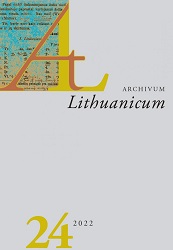Kazimiero Jauniaus marginalijos Jono Jablonskio Lietuviškos kalbos gramatikoje (1901)
Kazimieras Jaunius Marginal Notes in the Grammar of the Lithuanian Language by Jonas Jablonskis (1901)
Author(s): Jurgita VenckienėSubject(s): Syntax, Historical Linguistics, Baltic Languages, Pre-WW I & WW I (1900 -1919)
Published by: Lietuvių Kalbos Institutas
Keywords: Kazimieras Jaunius; Lithuanian language; Lithuanian grammar;
Summary/Abstract: The Grammar of the Lithuanian Language by Jonas Jablonskis (Tilžė, 1901; MLLM : MB 206; hereinafter – JaG) with marginalia is preserved in the Maironis Memorial Library (Maironis Museum of Lithuanian Literature, Kaunas). Until now, it has been assumed that the marginalia in this copy of the JaG belongs to Maironis himself. Indeed, the marginalia are of two kinds: the handwriting, writing tools (black pen and pencil), content and writing intentions differ, and it is obvious they were written by two people. The handwriting of the corrections in black pen is very similar to Maironis’ and coincides with his notes in Kazimieras Jaunius’ Lithuanian Grammar (St Petersburg, 1911; MLLM : MB 212). So it is very likely that Maironis was the author of the marginal notes in black pen. The majority of the JaG marginalia is written in pencil. The particulary interested and attentive reader wrote various notes on the cover, in the margins, and between the lines: he revised, supplemented, corrected the text of the grammar, and compared it with the works of Indo-European and Lithuanian linguistics. The handwriting of these notes differs from that of Maironis. Moreover, Kazimieras Jaunius’ special characters <a̧>, <ę>, <i̧>, <u̧>, <ɥ>, <ɯ>, <ȯ>, <i>, <tŝ>, <ḷ>, <ŝ>, <ẑ> were used. Maironis, a former student of Jaunius, wrote only some of his characters at one time or another. When starting to look for the sources of JaG marginalia, their author became evident. Several publications mentioned in the marginalia were found in the Martynas Mažvydas National Library of Lithuania, in the Kazimieras Jaunius archive. These were Herman Hirt’s Der indogermanische Akzent (Strassburg, 1895); August Leskien’s and Karl Brugman’s Litauische Volkslieder und Märchen (Strassburg, 1882); Jan Karlowicz’s O języku litewskim ([Kraków], 1875) and Antanas Baranauskas’ and Hugo Weber’s Ostlitauische Texte (Weimar, 1882). These books have marginalia written in pencil in the same handwriting as JaG. Stasys Skrodenis attributed these remarks to Jaunius. The handwriting, orthography, terms, and the stylistics of the marginal notes in JaG and the above-mentioned books coincide, and the writer commented on both works of Lithuanian and Indo-European linguistics. So the marginalia in JaG were written by Jaunius and not Maironis. The question how JaG with marginalia by Jaunius got to Maironis remains unanswered. Twenty-nine sources are mentioned in the marginalia of JaG: old Lithuanian writings, authors and publications of linguistics (Indo-European and Lithuanian), folklore, and others. Baranauskas’ Замѣтки о литовскомъ языкѣ и словарѣ (Notes about the Lithuanian Language and Vocabulary; St Petersburg, 1898) and Ostlitauische Texte (Weimar, 1882) published with Weber are the most frequently cited. Jaunius wrote marginalia in all sections of JaG. He compared the material in JaG with the aforementioned sources and dialects, and added additional information and corrected mistakes. It is difficult to say exactly what motives led Jaunius to study JaG so carefully. Perhaps because his Lithuanian Grammar was prepared from 1903, when Kazimieras Būga became his secretary. It is also known that Jaunius was to give a lecture on the normalisation of the Lithuanian language at the beginning of 1905. JaG could have been the source for this lecture.
Journal: Archivum Lithuanicum
- Issue Year: 2022
- Issue No: 24
- Page Range: 187-216
- Page Count: 36
- Language: Lithuanian

